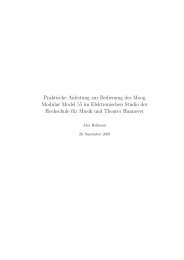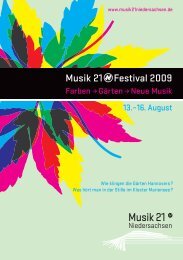Creating reverb efects using granular synthesis
Creating reverb efects using granular synthesis
Creating reverb efects using granular synthesis
You also want an ePaper? Increase the reach of your titles
YUMPU automatically turns print PDFs into web optimized ePapers that Google loves.
“particle verb” one can also hear a kind of grain scattering, which can also indicate that<br />
this is a variant of grain delay.<br />
I. Granular <strong>reverb</strong>s<br />
Commercial <strong>granular</strong> <strong>reverb</strong>s<br />
In the physical world, <strong>reverb</strong> is generated by reflection from surfaces around the sound<br />
source giving the sound object 1 a short tail. In the early days of spatial effects, sounds<br />
were played back into an echo chamber and recorded to produce such effects. Later, tapedelay<br />
machines could produce the illusion of early reflections by delaying the incoming<br />
signal. A combination of allpass and comb filters has been used to create artificial <strong>reverb</strong><br />
(e.g. Moorer <strong>reverb</strong>, Gardner <strong>reverb</strong>, Freeverb), and feedback delay networks (e.g.<br />
<strong>reverb</strong>sc in Csound) constitute another well-known technique. Currently, also<br />
convolution (Boulanger, 2000: 507) has been used to artificially recreate the response of<br />
a physical room or hall. Granular synthesized <strong>reverb</strong> is more like the delay-effect in the<br />
way that it makes use of the early reflection illusion, but resembles <strong>reverb</strong> in that it also<br />
creates <strong>reverb</strong>-like, lush tails. One could easily term <strong>granular</strong> <strong>reverb</strong> more of a special<br />
effect then a “realistic” effect.<br />
A <strong>granular</strong> <strong>reverb</strong> effect in Csound can be created the same way as Ableton Lives<br />
“grain delay”, with a delayed signal that is chopped up to smaller grains and treated with<br />
<strong>granular</strong> <strong>synthesis</strong>. This is shown in example1.csd. To emulate the Line 6 “octaverb”, we<br />
can use the same example as with the grain delay, but with grain pitch one octave above.<br />
Further expansion on the concept of <strong>granular</strong> <strong>synthesis</strong> as a <strong>reverb</strong><br />
effect<br />
Another way to create a long tail is to stretch the sound object in the time domain. This is<br />
easily done <strong>using</strong> <strong>granular</strong> <strong>synthesis</strong>. One can “chop” the sound object into grains and<br />
stretch the duration of the entire sound object by filling the empty spaces between the<br />
grains with nearby grains. This way we get a longer sound object with the same structure<br />
as the shorter sound object, and without a drop in pitch.<br />
Time stretch <strong>using</strong> <strong>granular</strong> <strong>synthesis</strong><br />
With low grain rates less than 30 Hz, the pitch of the sound object is perceived<br />
through transposition of the source audio, as the original source waveform is not distorted<br />
by <strong>granular</strong> amplitude modulation. We can to some extent avoid the AM effect at higher<br />
grain rates too, by <strong>using</strong> a small random deviation on the sample position for reading<br />
grains.<br />
1 Sound object is described as one isolated sound event, for example a note or a drum hit<br />
or the sound of a train passing by (Roads, 2001)










